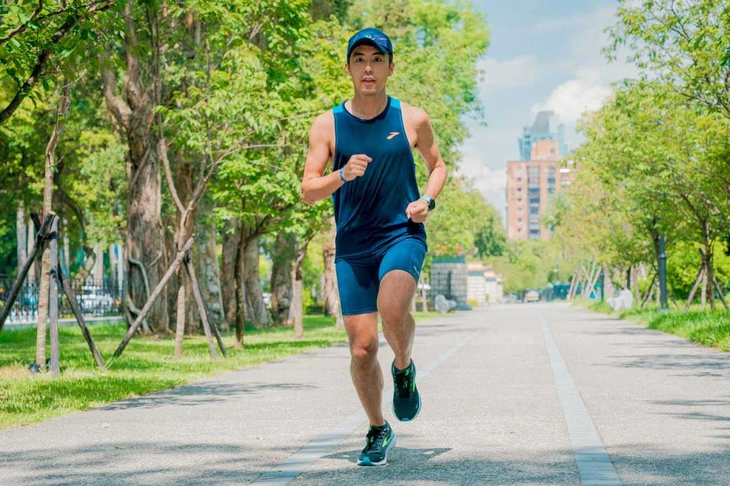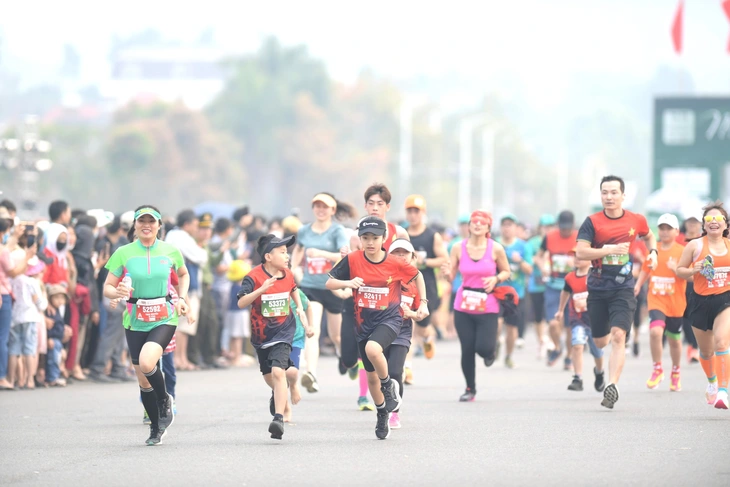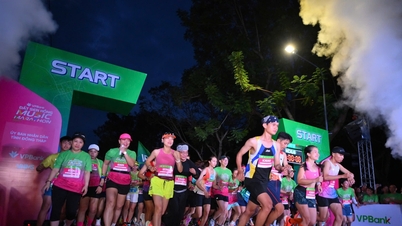
Many runners give up pursuing goals in favor of the comfort of running - Photo: UT
While most runners compete in groups, setting goals for speed, distance, or calories burned, a new trend is quietly spreading.
Mindful running - running not to achieve results, but to reconnect with yourself, through every breath and step.
From city parks to online running communities, more and more people are starting to adopt a quiet style of running. They don’t track GPS, don’t talk, don’t push themselves to run faster, just focus on the feel of their bodies, the sound of their footsteps, and the space around them.
In the US, Europe, and Japan, mindful running has become part of mental health support programs, helping to recover from stress or anxiety disorders. “Running meditation” training classes organized by mental health organizations, hospitals, or holistic care centers are attracting thousands of participants.
What is mindful running?
Mindful running is a form of physical activity that incorporates mindfulness practice – that is, paying full attention to the present moment. Runners are not concerned with the destination or performance, but rather focus on their breathing, the contact between their feet and the ground, and the sensations that are occurring in their body and mind.
“Mindful running is about being truly present in every movement,” says Tara Brach, clinical psychologist and author of “Radical Acceptance.” “Not worrying about the past or the future, but feeling fully present in the moment.”
The concept of mindful running originates from the intersection of Buddhist meditation and modern psychological theories.
One of the pioneers who brought this method to the West was Sakyong Mipham Rinpoche, a Tibetan lama. In his 2012 book, “Running with the Mind of Meditation,” he emphasized: “The body in motion is the ideal foundation for meditation. Mindfulness does not necessarily come from sitting still.”
Since 2015, several universities including Harvard, Stanford, and the University of Wisconsin-Madison have experimented with combining meditation and physical activity in mental health support programs.
On fitness and mental health platforms like Headspace and Calm, mindfulness-based running tutorials are also being introduced to global users.
Benefits from a scientific perspective
More than just a trend, mindful running has been seriously studied in the neuroscience and psychology world.
A study from the University of Arizona, published in the journal Mindfulness in 2020, found that a group of people who ran mindfully for six weeks significantly reduced anxiety symptoms, improved sleep, and improved emotional regulation.

Mindful jogging spreads to the West - Photo: TA
“Mindful running helps the brain disconnect from the anxiety loop,” says Dr. Michael Amster, chronic pain specialist and co-author of “The Power of Awe.” “When we pay attention to how our bodies feel, we get out of automatic, negative thought patterns.”
Research also found that mindful running increased activity in the prefrontal cortex – which coordinates focus and emotional control – and calmed the sympathetic nervous system, which is overactive in people who are chronically stressed.
Another study in the Journal of Health Psychology found that mindful runners had higher heart rate variability (HRV) – a biological marker of better stress resilience.
Celebrities also turn to mindful running
Many athletes and artists share that they find balance in this running method.
“I used to run to forget sadness,” says Canadian singer Alanis Morissette. “But now I run to stay with it, to accept it and overcome it. Every step is a way to heal.”
Marathon runner Deena Kastor, a former US national record holder, shares in her memoir “Let Your Mind Run”: “When you put your mind to every step, you not only run faster but you live better.”

Jogging is a sport chosen by many people today - Photo: TTO
Basic instructions for practice
Mindful running doesn’t require special equipment or a professional trainer. Anyone can get started with these simple principles:
– Choose a quiet, open place, maybe a park or a running track with few people.
– Turn off your phone, do not wear headphones or tracking devices.
– Start by walking slowly, then move on to jogging at a light pace.
– Focus on your breathing: inhale, exhale, feel the air go through your nose, chest, and abdomen.
– Feel the feet touching the ground, the movement of the arms, the stretch of the body.
– Whenever your mind wanders, gently bring your attention back to your steps and breathing.
– After about 10-20 minutes, finish with a few minutes of walking and relaxing your whole body.
Source: https://tuoitre.vn/chay-bo-chanh-niem-mang-tin-nguong-phat-giao-vao-moi-buoc-chan-20250616002710273.htm



![[Photo] Prime Minister Pham Minh Chinh receives the Chairman of the Japan-Vietnam Friendship Association in the Kansai region](https://vphoto.vietnam.vn/thumb/1200x675/vietnam/resource/IMAGE/2025/11/03/1762176259003_ndo_br_dsc-9224-jpg.webp)
![[Photo] Fall Fair 2025 and impressive records](https://vphoto.vietnam.vn/thumb/1200x675/vietnam/resource/IMAGE/2025/11/03/1762180761230_ndo_br_tk-hcmt-15-jpg.webp)
![[Photo] Lam Dong: Close-up of illegal lake with broken wall](https://vphoto.vietnam.vn/thumb/1200x675/vietnam/resource/IMAGE/2025/11/03/1762166057849_a5018a8dcbd5478b1ec4-jpg.webp)

![[Photo] General Secretary To Lam receives Singaporean Ambassador Jaya Ratnam](https://vphoto.vietnam.vn/thumb/1200x675/vietnam/resource/IMAGE/2025/11/03/1762171461424_a1-bnd-5309-9100-jpg.webp)






































































































Comment (0)